Five things you need to know about kitesurfing.
1. How to get into kitesurfing – where to learn and what you’ll need.
Kitesurfing is super fun and safe if you are using the correct equipment, in an obstacle-free location with the appropriate wind and best water conditions. Understanding what all these things are is key; so to have the most fun while you’re learning and to establish great skills from the start, you need to take a lesson with a professional instructor.
In your first lesson, you’ll learn all about the wind window and all of the variables that affect the kite and its power.
In kitesurfing, 80% of the sport is about controlling the kite and just 20% involves board control. So to start, you’ll be hooked in and flying the kite in no time, practicing a series of kited-based maneuvers on land before the board is introduced. Here you’ll get your first experience of how the kite flies and the power you can generate from it.
If you have transferable board skills from wakeboarding or snowboarding, for example, you should find the board side of kiting relatively similar. The challenge for everyone, whether you have previous skills or not, is mastering the kite.
The average person needs about 5-10 hours of kitesurfing lessons with a professional kite school in an ideal location. An additional 20-40 hours of practice time will be the foundation for being able to stay upwind and hit the waves, try jumps or learn to foil.
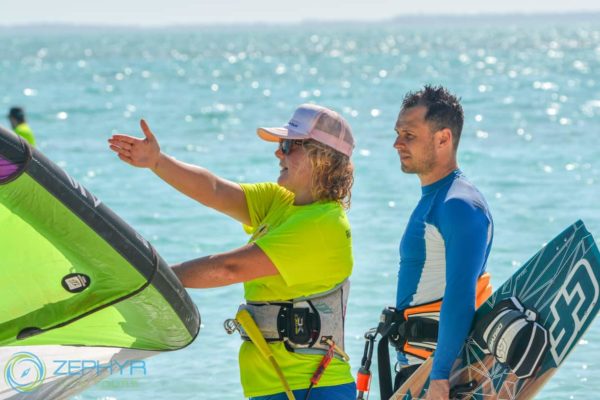
2. The challenge of becoming a kite surfer – it’s not the easiest sport to master, but it is the most rewarding sport to learn.
All kitesurfers have walked what feels like 1000 miles up the beaches before they master staying upwind. We have all had a friendly kiter launch and land our kites, offer tips, advice and a helping hand because everyone was a learner at one stage.
Kitesurfing does take some time to learn and the best fuel to speed up the progress is consistency. Consistent wind and daily practice a few times a week is ideal while learning.
We recommend the best way to learn to kite is an intensive approach where you clock up 20+ hours of kitesurfing practice. Invest the time at the beginning and you’ll gain enough experience to go kiting anywhere any time – like a quick lunchtime session, an after-work buzz around or a weekend away with your new kiting buddies.
On a Zephyr progression tour to the Cocos Islands, you’ll get intensive tuition everyday in some of the most consistent wind on the planet. For most people, they can get a whole season’s worth of kiting and progression in just ten days, which saves you heaps of time and money and, more importantly, gets you to where you want to be in your new sport as quickly as possible.
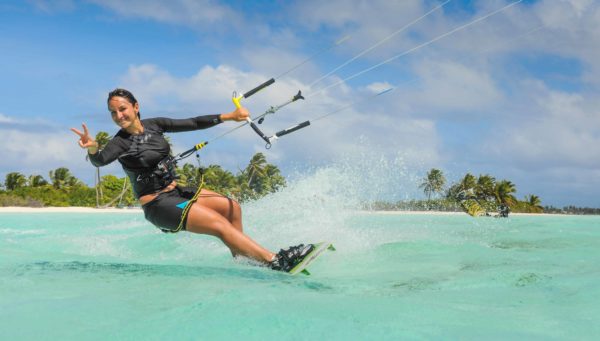
3. How Kitesurfing works – the process & mechanics.
Kitesurfing involves using the power of the wind and the resistance of the board to drive yourself across, or even up against the direction of the wind. Kitesurfers use the same principles sailing boats use to tack upwind.
The kite is effectively a sail which is attached to your waist harness via your bar and 24-30 metre lines. The length of the lines is so the sail/kite can catch more wind and be maneuvered over a greater distance.
The board edge or fins are your keel or ‘edge’ which is used to steer and angle your direction across and up against the wind.
As you start to accelerate and generate momentum on your board, you increase the airflow over the foil of the kite. The more air that passes across the canopy of the kite, the more power you generate.
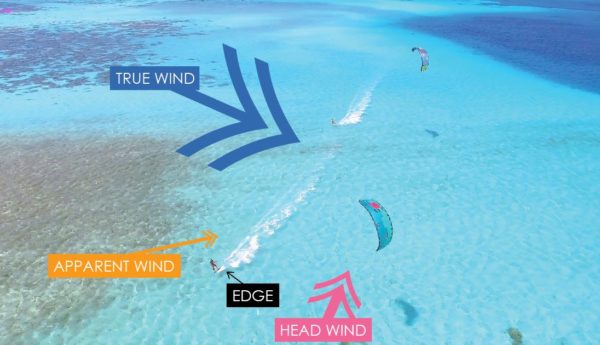
4. What style of kitesurfing is for you? So many different styles to try and explore.
There are many names for kiting: kitesurfing, kiteboarding, foilkiting, snowkiting and the list goes on. You can literally go anywhere with a kite and play in almost any condition from super light to gale force winds, flat water, waves, open ocean, sand, and even snow!
Freeride kitesurfing
Freeriding is the easiest and most relaxing way to enjoy the water. You can use most styles of kites and an average sized board. Cruising up and down the beach or doing long downwinders and adventures are a great way to explore the ocean on a kite.
Freestyle kitesurfing
Freestyle can be as simple as a back roll or jump transition, but hardcore freestyle is what we see at competitions with spins, kite loops and handle passes. Freestyle kites are fast turning and the boards have loads of ‘pop’ – like a wakeboard.
Wave kitesurfing
If you live near the coast, then wave riding the sea breezes will get you on the water more. Wave boards are a lot like a regular surfboard but tend to be stronger, a little heavier and can have sharper edges for going upwind. Wave kites ‘drift’ so you can turn off the power to ride the wave unassisted, just like surfing.
Snow kiting
Snowkiting is a great way to kite all year around. Using your kite instead of the T-bar, you can explore the backcountry and create your own fresh tracks. You can ski or snowboard and use the popular inflatable water kites. If you’re dedicated to the mountains, soft foil kites work better as they are lighter to maneuver and more durable.
Land kiting
Just like snowkiting, you can use any kite to get around on sand dunes, beaches or in wide open parks or plains. Skateboards or buggies have wheels best suited to the terrain but it’s essential to have a quick release safety system in case you fall off. The land isn’t as soft as water or snow!
Foil kiting
Foil kitesurfing is the newest way to get around. Instead of using the edge of your board or fins to push against the water, an underwater horizontal wing sits flat off a long shaft under your board to glide underwater and give lift. Foil kitesurfing is for light winds and long-distance riding with amazing upwind ability.
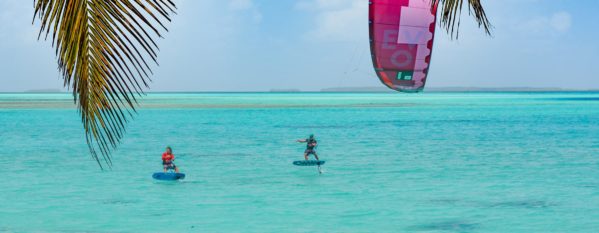
5.What you need to kitesurf – the gear and equipment
Count your fingers and thumb – 5 musts to get on the water:
- Board
- Kite
- Bar and Lines
- Harness
- Pump
You may also need a wetsuit or rash vest depending on the water temperature, and for extra safety, you can use a helmet and impact vest. Make sure you have plenty of sunscreen or my preferred choice; surf mud – the natural zinc/sunblock. https://surfmud.com/
The great thing about Kitesurfing is that you can have all your gear in the back of your car, bike or take it on the plane as it’s super-compact and straightforward to travel with.
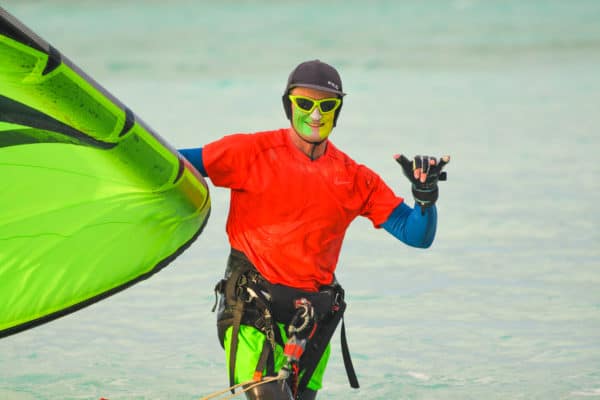
“Kitesurfing is a thrill, and the sport has many rewards!
Feel the adrenalin on the water, enjoy being in the elements and join a tribe with a shared passion”.
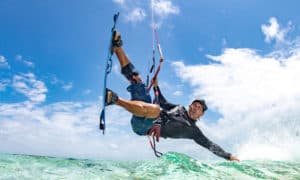 This post was written by Ben Strowger – Stoke Coach, Owner and Manager of Zephyr Tours & Ocean Addicts QLD.
This post was written by Ben Strowger – Stoke Coach, Owner and Manager of Zephyr Tours & Ocean Addicts QLD.
